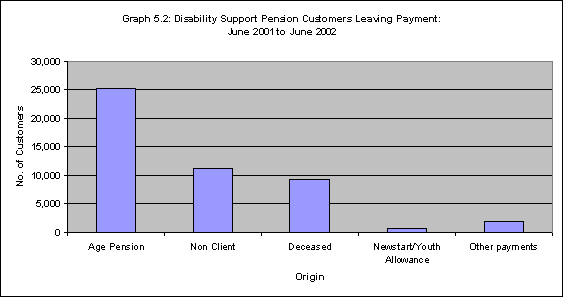Characteristics of Disability Support Pension Customers, June 2002
Attachments
Table of Contents
- Overview
- 1. Disability Support Pension Population Characteristics
- 2. Medical Condition
- 3. Earnings and Duration on Income Support
- 4. New Claims
- 5. Where DSP Recipients are Coming From and Going To
Disability Support Pension - Overview
Who is this Payment for?
Disability Support Pension (DSP) is paid to people who are unable to work for at least 30 hours per week, or be re-skilled for such work, for more than two years because of a disability. DSP is intended to ensure that people with disabilities have adequate levels of income and maximum opportunities to participate in society.
Eligibility Requirements
To qualify for DSP a person must:
- be over 16 and be under Age Pension age (currently 62 for women and 65 for men); and
- be permanently blind; or
- have a physical, intellectual or psychiatric impairment (assessed at 20 points or more under the Impairment Tables); and be unable to do any work, or be re-skilled for any work, for a period of at least two years; and
- have become unable to work while in Australia, or have 10 years qualifying Australian residence.
Trends
As at June 2002, there were 658,915 people receiving DSP. Two thirds of these customers were aged over 45 years; 62% were male; 72% were born in Australia; only 9.7% had income from employment though 16% were on reduced rates due to their or their partner's income or assets; and, on average, they had been in continuous receipt of DSP for 7 years. The three main medical conditions are musculo-skeletal or connective tissue conditions, representing 33% of the total DSP population, psychological/psychiatric conditions, representing 24%, and intellectual/learning difficulties, representing 10%.
Since 1972 the DSP customer population has been steadily increasing, with the greatest growth, of 13%, occurring in the 1991-92 financial year following the introduction of the Disability Reform Package. In recent years, this growth slowed to a rate of around 4% each year but has increased again in 2001-02 to 5.6%. The proportion of females is also increasing and females now represent 38% of the total DSP population.
Over 88,000 claims for DSP were granted in the 2001-02 financial year and over 42,000 claims were rejected (32.5% of total claims processed). Lack of medical eligibility was the main reason for rejecting a claim for DSP.
Over half of people coming onto Disability Support Pension are coming from other income support payments with the main payments being Newstart of Youth Allowance (37%), Parenting Payments (5%) and Sickness Allowance (4%). 44% were not previously in receipt of another Centrelink payment.
This report was prepared by the Disability Payments Section, Office of Disability.
[ Return to Top Return to Section ]
1:Disability Support Pension Population Characteristics
1.1 Customers by Gender 1972 to 2002
As at June 2002, the number of people receiving Disability Support Pension (DSP) was 658,915 and has been steadily increasing since 1972, with the greatest growth period (13%) occurring in 1992 following the introduction of the Disability Reform Package. In recent years, the growth rate slowed to around 4%, but has increased in the 2001-02 financial year to 5.6%.
A number of factors have been suggested as contributing to the increases in the DSP customer numbers in the last decade:
- changed eligibility criteria for disability payments following the introduction of the Disability Reform Package;
- loss of access to other forms of support such as Veterans' Affairs Service Pension, Widow B and Wife Pension;
- increases in the Age Pension qualifying age for females;
- demographic effects such as the ageing of the population; and
- changes in the labour market which have resulted in a reduced capacity for people with disabilities to retain or find work.
The proportion of the DSP population that is female has been increasing, from a low of 26% in 1989 to the current figure of 38% of the DSP population.
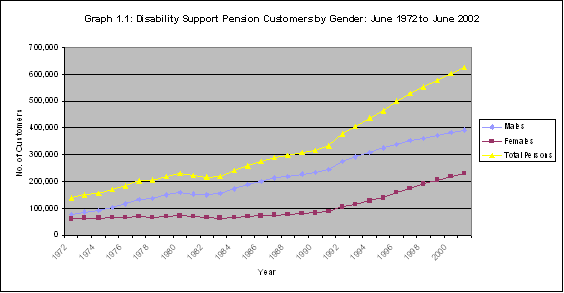
Source: Characteristics of Disability Support Pension Customers (June 2001); Superstar Pensions Database 16/06/2002
| At June each year |
Males
|
Females
|
Total Persons
|
|||||
|---|---|---|---|---|---|---|---|---|
| Count | Change | % of total | Count | Change | % of total | Count | % growth | |
| 1972 | 77,133 | 55.56% | 61,685 | 44.44% | 138,818 | |||
| 1973 | 85,305 | 8,172 | 57.02% | 64,304 | 2,619 | 42.98% | 149,609 | 7.77% |
| 1974 | 92,140 | 6,835 | 58.77% | 64,643 | 339 | 41.23% | 156,783 | 4.80% |
| 1975 | 102,817 | 10,677 | 60.92% | 65,967 | 1,324 | 39.08% | 168,784 | 7.65% |
| 1976 | 116,118 | 13,301 | 63.18% | 67,669 | 1,702 | 36.82% | 183,787 | 8.89% |
| 1977 | 133,209 | 17,091 | 65.63% | 69,754 | 2,085 | 34.37% | 202,963 | 10.43% |
| 1978 | 137,245 | 4,036 | 66.97% | 67,699 | -2,055 | 33.03% | 204,944 | 0.98% |
| 1979 | 149,759 | 12,514 | 68.12% | 70,084 | 2,385 | 31.88% | 219,843 | 7.27% |
| 1980 | 158,327 | 8,568 | 69.07% | 70,892 | 808 | 30.93% | 229,219 | 4.26% |
| 1981 | 153,889 | -4,438 | 69.33% | 68,062 | -2,830 | 30.67% | 221,951 | -3.17% |
| 1982 | 151,146 | -2,743 | 69.77% | 65,503 | -2,559 | 30.23% | 216,649 | -2.39% |
| 1983 | 155,672 | 4,526 | 70.67% | 64,617 | -886 | 29.33% | 220,289 | 1.68% |
| 1984 | 173,063 | 17,391 | 71.94% | 67,511 | 2,894 | 28.06% | 240,574 | 9.21% |
| 1985 | 188,713 | 15,650 | 72.82% | 70,449 | 2,938 | 27.18% | 259,162 | 7.73% |
| 1986 | 200,898 | 12,185 | 73.37% | 72,912 | 2,463 | 26.63% | 273,810 | 5.65% |
| 1987 | 213,290 | 12,392 | 73.79% | 75,760 | 2,848 | 26.21% | 289,050 | 5.57% |
| 1988 | 219,168 | 5,878 | 73.82% | 77,745 | 1,985 | 26.18% | 296,913 | 2.72% |
| 1989 | 227,285 | 8,117 | 73.84% | 80,510 | 2,765 | 26.16% | 307,795 | 3.67% |
| 1990 | 233,251 | 5,966 | 73.65% | 83,462 | 2,952 | 26.35% | 316,713 | 2.90% |
| 1991 | 244,699 | 11,448 | 73.21% | 89,535 | 6,073 | 26.79% | 334,234 | 5.53% |
| 1992 | 273,697 | 28,998 | 72.30% | 104,861 | 15,326 | 27.70% | 378,558 | 13.26% |
| 1993 | 291,471 | 17,774 | 71.69% | 115,101 | 10,240 | 28.31% | 406,572 | 7.40% |
| 1994 | 309,123 | 17,652 | 70.86% | 127,111 | 12,010 | 29.14% | 436,234 | 7.30% |
| 1995 | 324,672 | 15,549 | 69.91% | 139,758 | 12,647 | 30.09% | 464,430 | 6.46% |
| 1996 | 340,256 | 15,584 | 68.16% | 158,979 | 19,221 | 31.84% | 499,235 | 7.49% |
| 1997 | 352,607 | 12,351 | 66.84% | 174,907 | 15,928 | 33.16% | 527,514 | 5.66% |
| 1998 | 361,539 | 8,932 | 65.34% | 191,797 | 16,890 | 34.66% | 553,336 | 4.90% |
| 1999 | 373,340 | 11,801 | 64.63% | 204,342 | 12,545 | 35.37% | 577,682 | 4.40% |
| 2000 | 382,351 | 9,011 | 63.48% | 219,929 | 15,587 | 36.52% | 602,280 | 4.26% |
| 2001 | 392,354 | 10,003 | 62.88% | 231,572 | 11,643 | 37.12% | 623,926 | 3.59% |
| 2002 | 406,893 | 14,539 | 61.75% | 252,022 | 20,450 | 38.25% | 658,915 | 5.61% |
Source: Characteristics of Disability Support Pension Customers (June 2001); Superstar Pensions Database 16/06/2002
1.2 Customers by Age and Gender
People age 55 years and over represent 40% of the overall DSP customer population. The very small proportion of females in the 60 to 64 years age group is due to the lower Age Pension qualifying age for women. As the qualifying age increases for females, it is expected that this age group will grow and eventually exceed the number in the 55 to 59 years age group. The qualifying age for women is currently 62 years. The trend in the graph below is consistent with the trend for all Australians with a disability, which shows that the occurrence of a disability increases with age.
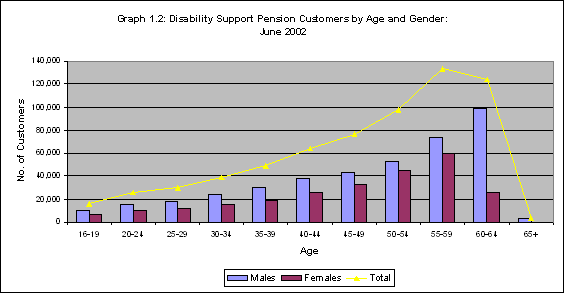
Source: Superstar Pensions Database 16/06/2002
| AGE |
Males
|
%
|
Females
|
%
|
Total
|
%
|
|---|---|---|---|---|---|---|
| 16-19 | 9,648 | 2.37% | 6,436 | 2.55% | 16,084 | 2.44% |
| 20-24 | 15,065 | 3.70% | 10,827 | 4.30% | 25,892 | 3.93% |
| 25-29 | 17,585 | 4.32% | 11,942 | 4.74% | 29,527 | 4.48% |
| 30-34 | 23,754 | 5.84% | 15,398 | 6.11% | 39,152 | 5.94% |
| 35-39 | 30,387 | 7.47% | 18,704 | 7.42% | 49,091 | 7.45% |
| 40-44 | 38,433 | 9.45% | 25,531 | 10.13% | 63,964 | 9.71% |
| 45-49 | 43,334 | 10.65% | 32,979 | 13.09% | 76,313 | 11.58% |
| 50-54 | 52,832 | 12.98% | 45,050 | 17.88% | 97,882 | 14.86% |
| 55-59 | 73,811 | 18.14% | 59,352 | 23.55% | 133,163 | 20.21% |
| 60-64 | 98,886 | 24.30% | 25,503 | 10.12% | 124,389 | 18.88% |
| 65+ | 3,158 | 0.78% | 300 | 0.12% | 3,458 | 0.52% |
| Total | 406,893 | 100.00% | 252,022 | 100.00% | 658,915 | 100.00% |
Source: Superstar Pensions Database 16/06/2002
1.3 Customers by Geographic State
As expected the majority of DSP customers can be found in the more populous Australian States. New South Wales is the largest with 33% of the DSP population, while the Northern Territory is the smallest with 0.8%.
When compared with the ABS Census 2001, the proportion of DSP customers living in Tasmania and South Australia is higher than the proportion of the total Australian population in these States.
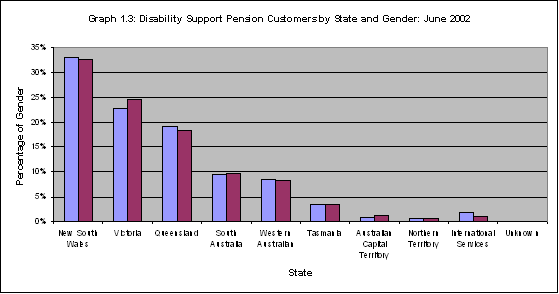
Source: Superstar Pensions Database 16/06/2002
| STATE |
Males
|
%
|
Females
|
%
|
Total DSP
|
DSP %
|
ABS Census 2001
|
|---|---|---|---|---|---|---|---|
| New South Wales | 134,452 | 33.04% | 82,029 | 32.55% | 216,481 | 32.85% | 33.58% |
| Victoria | 92,530 | 22.74% | 62,055 | 24.62% | 154,585 | 23.46% | 24.48% |
| Queensland | 78,253 | 19.23% | 46,137 | 18.31% | 124,390 | 18.88% | 19.27% |
| South Australia | 38,340 | 9.42% | 24,501 | 9.72% | 62,841 | 9.54% | 7.73% |
| Western Australian | 33,958 | 8.35% | 20,987 | 8.33% | 54,945 | 8.34% | 9.76% |
| Tasmania | 14,331 | 3.52% | 8,629 | 3.42% | 22,960 | 3.48% | 2.41% |
| Australian Capital Territory | 3,766 | 0.93% | 2,902 | 1.15% | 6,668 | 1.01% | 1.64% |
| Northern Territory | 3,359 | 0.83% | 1,860 | 0.74% | 5,219 | 0.79% | 1.11% |
| International Services | 7,690 | 1.89% | 2,827 | 1.12% | 10,517 | 1.60% | 0.01% |
| Unknown | 214 | 0.05% | 95 | 0.04% | 309 | 0.05% | 0.01% |
| Total | 406,893 | 100.00% | 252,022 | 100.00% | 658,915 | 100.00% | 100.00% |
Source: Superstar Pensions Database 16/06/02; ABS Census of Population and Housing 2015.0, 2001
1.4 Customers by Country of Birth
The majority of DSP customers were born in Australia (72.3%). The next largest group was those born in the United Kingdom (6.3%).
When compared with ABS Census 2001, countries such as Greece, Yugoslavia, Italy, Lebanon, Malta, Turkey and Germany are over-represented on DSP.
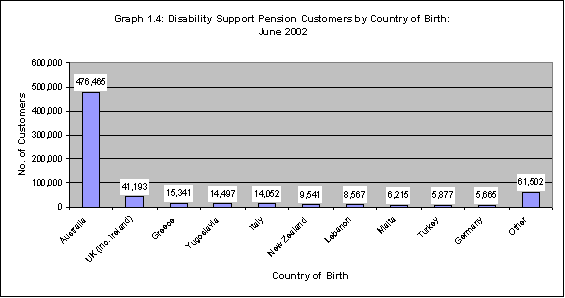
Source: Superstar Pensions Database 16/06/2002
| COUNTRY OF BIRTH |
Males
|
%
|
Females
|
%
|
Total DSP
|
DSP %
|
ABS Census 2001
|
|---|---|---|---|---|---|---|---|
| Australia | 289,169 | 71.07% | 187,296 | 74.32% | 476,465 | 72.31% | 71.84% |
| UK (inc. Ireland) | 26,739 | 6.57% | 14,454 | 5.74% | 41,193 | 6.25% | 5.73% |
| Greece | 9,821 | 2.41% | 5,520 | 2.19% | 15,341 | 2.33% | 0.61% |
| Yugoslavia | 9,759 | 2.40% | 4,738 | 1.88% | 14,497 | 2.20% | 0.29% |
| Italy | 9,561 | 2.35% | 4,491 | 1.78% | 14,052 | 2.13% | 1.15% |
| New Zealand | 5,909 | 1.45% | 3,632 | 1.44% | 9,541 | 1.45% | 1.88% |
| Lebanon | 6,109 | 1.50% | 2,458 | 0.98% | 8,567 | 1.30% | 0.38% |
| Malta | 4,592 | 1.13% | 1,623 | 0.64% | 6,215 | 0.94% | 0.25% |
| Turkey | 3,360 | 0.83% | 2,517 | 1.00% | 5,877 | 0.89% | 0.16% |
| Germany | 3,659 | 0.90% | 2,006 | 0.80% | 5,665 | 0.86% | 0.57% |
| Other | 38,215 | 9.39% | 23,287 | 9.24% | 61,502 | 9.33% | 17.15% |
| Total | 406,893 | 100.00% | 252,022 | 100.00% | 658,915 | 100.00% | 100.00% |
Source: Superstar Pensions Database 16/06/02; ABS Census of Population and Housing 2015.0, 2001
1.5 Customers by Marital Status and Gender
The majority of DSP customers are not partnered (61.9%) with females more likely to not have a partner than males (69.7% of the female population are not partnered, compared to 57.1% of males). Proportionally, males and females are similar in the defacto category. Males are more likely than females to be married or single while females are more likely to be divorced, separated or widowed.
The higher percentages of divorced, separated and widowed women could be the result of a number of factors:
- Women who have separated from a spouse who was the main income earner which resulted in them having to seek income support;
- The closing off of payments such as Widow B Pension; and
- The shorter lifespan of men increasing the probability of widowhood among women.
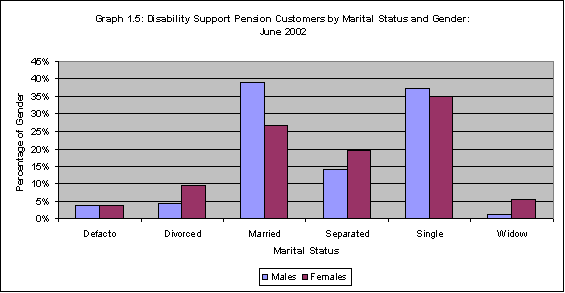
Source: Superstar Pensions Database 16/06/2002
| MARITAL STATUS |
Males
|
%
|
Females
|
%
|
Total
|
%
|
|---|---|---|---|---|---|---|
| Defacto | 15,513 | 3.81% | 9,663 | 3.83% | 25,176 | 3.82% |
| Divorced | 17,376 | 4.27% | 24,174 | 9.59% | 41,550 | 6.31% |
| Married | 159,061 | 39.09% | 66,783 | 26.50% | 225,844 | 34.28% |
| Separated | 57,571 | 14.15% | 49,256 | 19.54% | 106,827 | 16.21% |
| Single | 152,071 | 37.37% | 87,914 | 34.88% | 239,985 | 36.42% |
| Widow | 5,301 | 1.30% | 14,232 | 5.65% | 19,533 | 2.96% |
| Total | 406,893 | 100.00% | 252,022 | 100.00% | 658,915 | 100.00% |
Source: Superstar Pensions Database 16/06/2002
1.6 Customers by Gender and Home Ownership
The majority of DSP customers do not own their home (62.7%). Males receiving DSP are marginally more likely to own a home (including paying it off) than females.

Source: Superstar Pensions Database 16/06/2002
| HOUSING STATUS |
Males
|
%
|
Females
|
%
|
Total
|
%
|
|---|---|---|---|---|---|---|
| Home owner | 152,650 | 37.52% | 88,228 | 35.01% | 240,878 | 36.56% |
| Non homeowner | 251,324 | 61.77% | 161,854 | 64.22% | 413,178 | 62.71% |
| Not coded | 2,919 | 0.72% | 1,940 | 0.77% | 4,859 | 0.74% |
| Total | 406,893 | 100.00% | 252,022 | 100.00% | 658,915 | 100.00% |
Source: Superstar Pensions Database 16/06/2002
1.7 Customers by Age and Home Ownership
DSP customers who own their own home or are paying it off tend to be skewed towards the older age groups with the 55+ age groups containing more homeowners than non-homeowners.
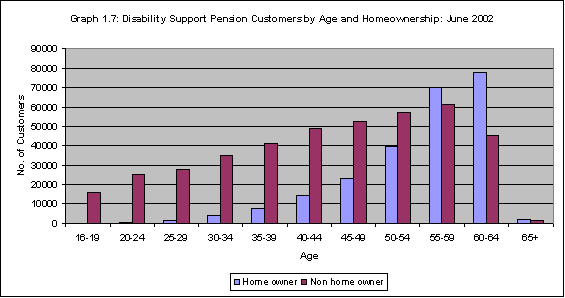
Source: Superstar Pensions Database 16/06/2002
| AGE |
Home owner
|
%
|
Non home owner
|
%
|
Not coded
|
%
|
Total | % |
|---|---|---|---|---|---|---|---|---|
| 16-19 | 130 | 0.05% | 15,945 | 3.86% | 9 | 0.19% | 16,084 | 2.44% |
| 20-24 | 439 | 0.18% | 25,428 | 6.15% | 25 | 0.51% | 25,892 | 3.93% |
| 25-29 | 1,389 | 0.58% | 28,096 | 6.80% | 42 | 0.86% | 29,527 | 4.48% |
| 30-34 | 3,839 | 1.59% | 35,231 | 8.53% | 82 | 1.69% | 39,152 | 5.94% |
| 35-39 | 7,828 | 3.25% | 41,122 | 9.95% | 141 | 2.90% | 49,091 | 7.45% |
| 40-44 | 14,528 | 6.03% | 49,159 | 11.90% | 277 | 5.70% | 63,964 | 9.71% |
| 45-49 | 23,106 | 9.59% | 52,744 | 12.77% | 463 | 9.53% | 76,313 | 11.58% |
| 50-54 | 39,730 | 16.49% | 57,277 | 13.86% | 875 | 18.01% | 97,882 | 14.86% |
| 55-59 | 70,248 | 29.16% | 61,483 | 14.88% | 1,432 | 29.47% | 133,163 | 20.21% |
| 60-64 | 77,751 | 32.28% | 45,146 | 10.93% | 1,492 | 30.71% | 124,389 | 18.88% |
| 65+ | 1,890 | 0.78% | 1,547 | 0.37% | 21 | 0.43% | 3,458 | 0.52% |
| Total | 240,878 | 100.00% | 413,178 | 100.00% | 4,859 | 100.00% | 658,915 | 100.00% |
Source: Superstar Pensions Database 16/06/2002
2:Medical Condition
2.1 Customers by Medical Condition
With the introduction of the DSP in 1991, the medical condition of customers was collected and recorded on their administrative file. Many of those customers who were already on payment have had their condition recorded or have left payment, although a significant number still have their medical condition unclassified (such as Invalid Pensioners who were granted prior to 12.11.91 who comprise 7% of the DSP population as at June 2002).
The medical conditions reported here represent the primary condition that is recorded on a customer's record. A customer may have multiple medical conditions but only the primary condition will be recorded.
The three largest groups are customers with Musculo-skeletal, Psychological/ Psychiatric or Intellectual/Learning medical conditions.
10,102 DSP customers are identified as being blind.

Source: Superstar Pensions Database 16/06/2002
2.2 Customers by Medical Condition and Gender
Males and females show a similar distribution of medical conditions. The only noticeable differences (ie. a greater than 2 percentage point difference) are in regards to Psychological/Psychiatric customers (26.0% female compared to 22.2% male), those with circulatory conditions (6.6% male and 3.4% female) and those with musculo-skeletal conditions (34.2% male and 32.0% female).
There is also a greater percentage of males who were former Invalid Pension recipients than females and therefore do not have their medical condition coded. This needs to be taken into account when interpreting the data as this may contribute to situations where the percentage of females with a particular condition appears greater than the percentage of males.
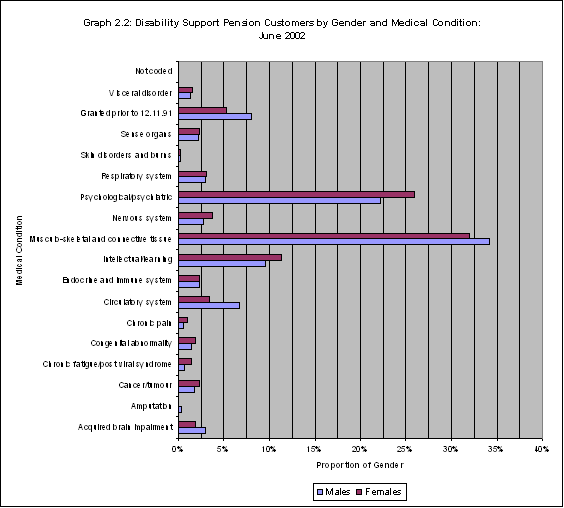
Source: Superstar Pensions Database 16/06/2002
| MEDICAL CONDITION |
Males
|
%
|
Females
|
%
|
Total
|
%
|
|---|---|---|---|---|---|---|
| Acquired brain impairment | 11,973 | 2.94% | 4,693 | 1.86% | 16,666 | 2.53% |
| Amputation | 1,374 | 0.34% | 311 | 0.12% | 1,685 | 0.26% |
| Cancer/tumour | 7,033 | 1.73% | 5,798 | 2.30% | 12,831 | 1.95% |
| Chronic fatigue/post viral syndrome | 2,584 | 0.64% | 3,655 | 1.45% | 6,239 | 0.95% |
| Congenital abnormality | 5,827 | 1.43% | 4,888 | 1.94% | 10,715 | 1.63% |
| Chronic pain | 2,234 | 0.55% | 2,513 | 1.00% | 4,747 | 0.72% |
| Circulatory system | 26,994 | 6.63% | 8,491 | 3.37% | 35,485 | 5.39% |
| Endocrine and immune system | 9,108 | 2.24% | 5,935 | 2.35% | 15,043 | 2.28% |
| Intellectual/learning | 38,712 | 9.51% | 28,378 | 11.26% | 67,090 | 10.18% |
| Musculo-skeletal and connective tissue | 139,198 | 34.21% | 80,542 | 31.96% | 219,740 | 33.35% |
| Nervous system | 10,993 | 2.70% | 9,512 | 3.77% | 20,505 | 3.11% |
| Psychological/psychiatric | 90,531 | 22.25% | 65,467 | 25.98% | 155,998 | 23.67% |
| Respiratory system | 11,973 | 2.94% | 7,799 | 3.09% | 19,772 | 3.00% |
| Skin disorders and burns | 1,003 | 0.25% | 674 | 0.27% | 1,677 | 0.25% |
| Sense organs | 8,753 | 2.15% | 5,888 | 2.34% | 14,641 | 2.22% |
| Granted prior to 12.11.91 | 32,919 | 8.09% | 13,291 | 5.27% | 46,210 | 7.01% |
| Visceral disorder | 5,460 | 1.34% | 4,000 | 1.59% | 9,460 | 1.44% |
| Not coded | 224 | 0.06% | 187 | 0.07% | 411 | 0.06% |
| Total | 406,893 | 100.00% | 252,022 | 100.00% | 658,915 | 100.00% |
Source: Superstar Pensions Database 16/06/2002
2.3 Customers by Musculo-skeletal, Psychological/Psychiatric and Intellectual Medical Conditions
The age distribution for Musculo-skeletal customers is skewed strongly towards the older age groups. This indicates a strong correlation between this type of condition and age.
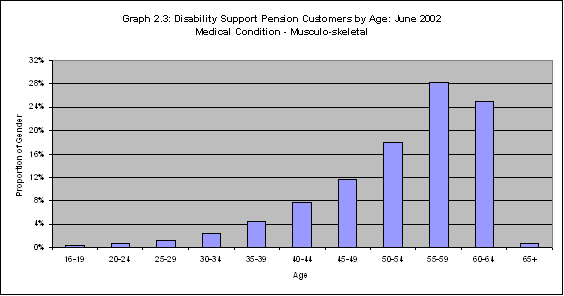
Source: Superstar Pensions Database 16/06/2002
Psychological/Psychiatric conditions also show a high representation in the older age groups but substantial numbers are in the younger age groups, leading to a more even distribution.
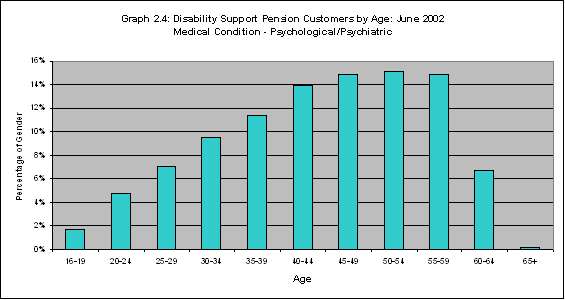
Source: Superstar Pensions Database 16/06/2002
Customers with Intellectual or Learning disabilities vary again in that they are skewed towards the younger age groups. The majority of these customers are born with their condition and may suffer a reduced lifespan as a result of their condition. This is reflected in information on duration on DSP for customers with these disabilities, where over half have been on payment for 10 years or more.
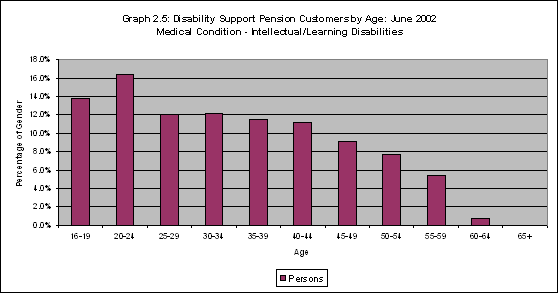
Source: Superstar Pensions Database 16/06/2002
A comparison of the age distributions of the total DSP population to customers granted in the 2001-02 financial year shows that:
- new customers with musculo-skeletal conditions have similar age distributions to the overall DSP population with the same condition;
- new customers with psychological/psychiatric conditions tend to be in the younger age groups (less than 45 years old) than the overall DSP population with the same condition; and
- new customers with Intellectual/Learning difficulties show a higher proportion of young customers (under 20 years) coming onto payment.
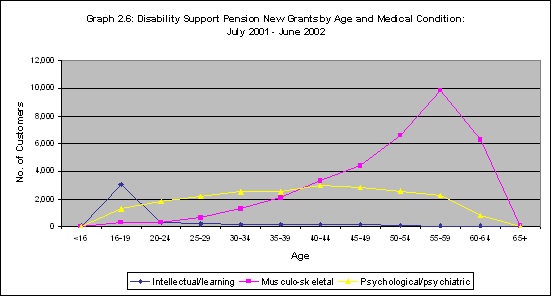
Source: Superstar Common Events Databases 14/07/01 to 16/06/2002
3:Earnings, Payment Rates and Duration
3.1 Customers with Earnings from Employment
Only a small percentage of DSP customers have earnings related to work (9.7%). This has increased from 8.4% in June 2000 and 9.1% in June 2001. The majority of customers have earnings in the lower income ranges. A small group of customers, comprising 18.9% of all those with earned income, earn in excess of $300 per week.
Under the current income test, a single DSP customer can earn up to $58 per week without their rate of payment being reduced. A couple can have a combined income of $102 per fortnight before the DSP customer's rate of payment is affected. Customers receiving allowances, such as Newstart Allowance, have lower income free thresholds. A Newstart Allowance customer can earn up to $31 per week before their rate of payment is affected.

Source: Superstar Pensions Database 16/06/2002
| EARNINGS |
Male
|
Earned only %
|
Female
|
Earned only %
|
Total
|
Earned only %
|
Total %
|
|---|---|---|---|---|---|---|---|
| No earnings | 368,170 | na | 226,880 | na | 595,050 | na | 90.31% |
| <$25pw | 5,289 | 13.66% | 3,871 | 15.40% | 9,160 | 14.34% | 1.39% |
| <$50pw | 6,843 | 17.67% | 4,689 | 18.65% | 11,532 | 18.06% | 1.75% |
| <$75pw | 5,655 | 14.60% | 3,538 | 14.07% | 9,193 | 14.39% | 1.40% |
| <$100pw | 3,502 | 9.04% | 1,842 | 7.33% | 5,344 | 8.37% | 0.81% |
| <$150pw | 4,072 | 10.52% | 2,585 | 10.28% | 6,657 | 10.42% | 1.01% |
| <$200pw | 2,245 | 5.80% | 1,749 | 6.96% | 3,994 | 6.25% | 0.61% |
| <$250pw | 1,870 | 4.83% | 1,442 | 5.74% | 3,312 | 5.19% | 0.50% |
| <$300pw | 1,435 | 3.71% | 1,159 | 4.61% | 2,594 | 4.06% | 0.39% |
| $300+pw | 7,812 | 20.17% | 4,267 | 16.97% | 12,079 | 18.91% | 1.83% |
| Total | 406,893 | 100.00% | 252,022 | 100.00% | 658,915 | 100.00% | 100.00% |
Source: Superstar Pensions Database 16/06/2002
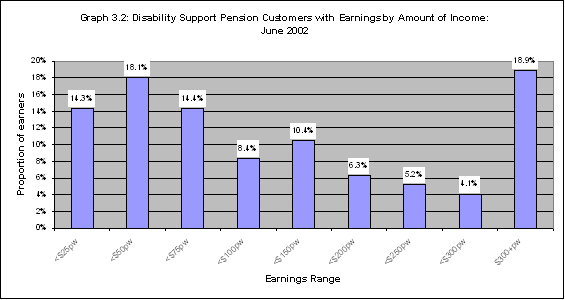
Source: Superstar Pensions Database 16/06/2002
When comparing the characteristics of DSP customers with earnings from employment to the characteristics of the overall DSP population it was found that:
- Single customers were more likely to have employment earnings. Single customers represented nearly 50% of the customers with employment earnings but only represented 36% of the total DSP population.
- Customers with intellectual or learning disabilities were also more likely to have employment income though the majority only had earnings of less than $75 per week. These customers represented 22% of customers with employment earnings but only represented 10% of the total DSP population.
- Customers aged less than 50 years were more likely to have earnings from employment than older customers. 63% of customers with employment income were aged less than 50 years but customers less than 50 only represented 46% of the total population.
3.2 Customers with Maximum/Reduced Rates of Payment
The majority of DSP recipients (83.9%) receive a full rate of pension. Customers may be receiving a part rate of payment due to:
- their income from employment or other investments;
- partner income from employment or other investments;
- repaying a debt; or
- repaying an advance.
Although only 9.7% of DSP customers have income from employment, there is a significant proportion (80.5%) that has income from other sources, such as superannuation, savings or income from investments. The majority of these customers have income below the income free threshold ($58 per week for a single customer) and therefore receive the maximum rate of DSP.
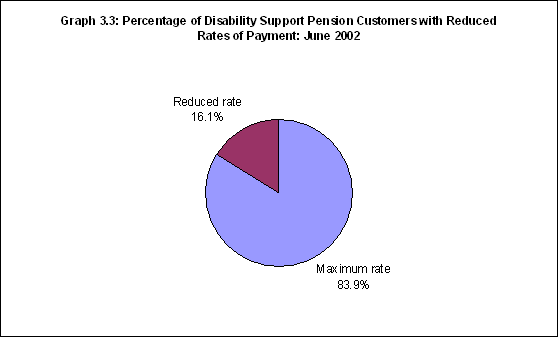
Source: Superstar Pensions Database 16/06/2002
| MAX RATE IND. |
Male
|
%
|
Female
|
%
|
Count
|
%
|
|---|---|---|---|---|---|---|
| Maximum rate | 343,773 | 84.49% | 208,810 | 82.85% | 552,583 | 83.86% |
| Reduced rate | 63,120 | 15.51% | 43,212 | 17.15% | 106,332 | 16.14% |
| Total | 406,893 | 100.00% | 252,022 | 100.00% | 658,915 | 100.00% |
Source: Superstar Pensions Database 16/06/2002
3.3 Customers by Current Duration on Payment and Gender
The distribution of duration on payment shows that the largest category is customers who have been continuously receiving DSP for 4 to 5 years, representing 13.9% of all DSP recipients. There is a significant group that have been on DSP for two years or less (33.4%). There is also a significant proportion of customers who have been in continuous receipt of DSP for 10 years or more (25% of all DSP customers).
The average length of time a customer spends on DSP continuously is 7 years, with no significant difference between males and females.
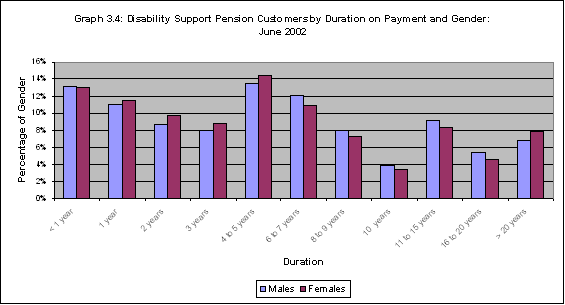
Source: Superstar Pensions Database 16/06/2002
| Duration |
Males
|
%
|
Females
|
%
|
Total
|
%
|
|---|---|---|---|---|---|---|
| < 1 year | 53,492 | 13.15% | 32,863 | 13.04% | 86,355 | 13.11% |
| 1 year | 44,800 | 11.01% | 28,991 | 11.50% | 73,791 | 11.20% |
| 2 years | 35,223 | 8.66% | 24,661 | 9.79% | 59,884 | 9.09% |
| 3 years | 32,845 | 8.07% | 22,275 | 8.84% | 55,120 | 8.37% |
| 4 to 5 years | 55,065 | 13.53% | 36,362 | 14.43% | 91,427 | 13.88% |
| 6 to 7 years | 49,051 | 12.06% | 27,486 | 10.91% | 76,537 | 11.62% |
| 8 to 9 years | 32,688 | 8.03% | 18,559 | 7.36% | 51,247 | 7.78% |
| 10 years | 16,065 | 3.95% | 8,505 | 3.37% | 24,570 | 3.73% |
| 11 to 15 years | 37,545 | 9.23% | 20,881 | 8.29% | 58,426 | 8.87% |
| 16 to 20 years | 22,334 | 5.49% | 11,565 | 4.59% | 33,899 | 5.14% |
| > 20 years | 27,785 | 6.83% | 19,874 | 7.89% | 47,659 | 7.23% |
| Total | 406,893 | 100.00% | 252,022 | 100.00% | 658,915 | 100.00% |
Source: Superstar Pensions Database 16/06/2002
3.4 Customers by Current Duration on Payment and Gender by those aged below 50 and those aged 50 years and over
DSP customers aged 50 years or over make up over half of the total DSP population. DSP customers over 50 years tend to have been on payment for longer periods than customers aged less than 50 years.
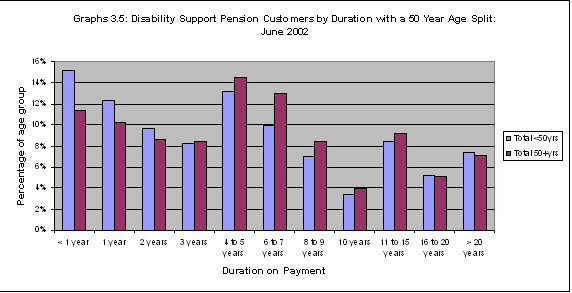
Source: Superstar Pensions Database 16/06/2002
|
<50 yrs
|
50+ yrs
|
|||||||
|---|---|---|---|---|---|---|---|---|
| Duration |
Male
|
Female
|
Total
|
% of total <50 yrs
|
Male
|
Female
|
Total
|
% of total 50+ yrs
|
| < 1 year | 27,811 | 17,747 | 45,558 | 15.18% | 25,681 | 15,116 | 40,797 | 11.37% |
| 1 year | 22,061 | 14,922 | 36,983 | 12.33% | 22,739 | 14,069 | 36,808 | 10.26% |
| 2 years | 16,715 | 12,185 | 28,900 | 9.63% | 18,508 | 12,476 | 30,984 | 8.63% |
| 3 years | 14,455 | 10,324 | 24,779 | 8.26% | 18,390 | 11,951 | 30,341 | 8.45% |
| 4 to 5 years | 23,010 | 16,349 | 39,359 | 13.12% | 32,055 | 20,013 | 52,068 | 14.51% |
| 6 to 7 years | 18,026 | 11,913 | 29,939 | 9.98% | 31,025 | 15,573 | 46,598 | 12.98% |
| 8 to 9 years | 12,903 | 8,160 | 21,063 | 7.02% | 19,785 | 10,399 | 30,184 | 8.41% |
| 10 years | 6,535 | 3,734 | 10,269 | 3.42% | 9,530 | 4,771 | 14,301 | 3.98% |
| 11 to 15 years | 15,448 | 10,023 | 25,471 | 8.49% | 22,097 | 10,858 | 32,955 | 9.18% |
| 16 to 20 years | 9,120 | 6,408 | 15,528 | 5.18% | 13,214 | 5,157 | 18,371 | 5.12% |
| > 20 years | 12,122 | 10,052 | 22,174 | 7.39% | 15,663 | 9,822 | 25,485 | 7.10% |
| Total | 178,206 | 121,817 | 300,023 | 100.00% | 228,687 | 130,205 | 358,892 | 100.00% |
Source: Superstar Pensions Database 16/06/2002
4:New Claims
4.1 New Claims Granted by Age and Gender
During the period 17 June 2001 to 16 June 2002, there were 88,171 new claims for DSP that were granted. This represents 67.5% of total claims processed.
Males make up 60.4% of new grants for DSP while females comprise 39.6%. These proportions are similar to the percentage distribution of males and females in the overall DSP population. Females currently make up 38.3% of the total DSP population. The age distribution of new grants also shows more customers in the age groups 16 to 19 and 40 to 59 years, than is found in the total DSP population.
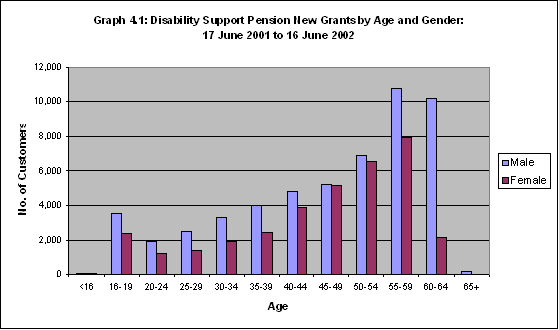
Source: Superstar Common Events Databases 14/07/01 to 16/06/2002
|
New grants
|
Total DSP customers
|
|||||||
|---|---|---|---|---|---|---|---|---|
| AGE |
Male
|
%
|
Female
|
%
|
Total
|
%
|
Total
|
%
|
| <16 | 49 | 0.09% | 41 | 0.12% | 90 | 0.10% | 0 | 0.00% |
| 16-19 | 3,541 | 6.65% | 2,390 | 6.84% | 5,931 | 6.73% | 16,084 | 2.44% |
| 20-24 | 1,944 | 3.65% | 1,221 | 3.50% | 3,165 | 3.59% | 25,892 | 3.93% |
| 25-29 | 2,455 | 4.61% | 1,398 | 4.00% | 3,853 | 4.37% | 29,527 | 4.48% |
| 30-34 | 3,271 | 6.14% | 1,881 | 5.39% | 5,152 | 5.84% | 39,152 | 5.94% |
| 35-39 | 3,967 | 7.45% | 2,401 | 6.87% | 6,368 | 7.22% | 49,091 | 7.45% |
| 40-44 | 4,814 | 9.04% | 3,894 | 11.15% | 8,708 | 9.88% | 63,964 | 9.71% |
| 45-49 | 5,226 | 9.82% | 5,129 | 14.68% | 10,355 | 11.74% | 76,313 | 11.58% |
| 50-54 | 6,854 | 12.87% | 6,547 | 18.74% | 13,401 | 15.20% | 97,882 | 14.86% |
| 55-59 | 10,786 | 20.26% | 7,916 | 22.66% | 18,702 | 21.21% | 133,163 | 20.21% |
| 60-64 | 10,197 | 19.15% | 2,106 | 6.03% | 12,303 | 13.95% | 124,389 | 18.88% |
| 65+ | 140 | 0.26% | 3 | 0.01% | 143 | 0.16% | 3,458 | 0.52% |
| Total | 53,244 | 100.00% | 34,927 | 100.00% | 88,171 | 100.00% | 658,915 | 100.00% |
Source: Superstar Common Events Databases 14/07/01 to 16/06/2002
4.2 Comparison of New Grants and Current Customers by Medical Condition
The distributions of new grants and current customers by medical condition are very similar. A few notable exceptions are the reduced percentage of new grants of customers with intellectual/learning disabilities and the increased number of new grants for customers with cancer, tumour or musculo-skeletal conditions.
When Invalid Pension ceased in November 1991, current customers were transferred to DSP. These customers did not have a medical condition recorded on their Centrelink record. They are being progressively reviewed and ascribed a medical condition, but as at June 2002, approximately 7% of the DSP population was still comprised of ex-Invalid Pension customers without a medical condition recorded.
By including these customers when looking at medical conditions, it has the effect of reducing the percentages in the other categories. Therefore, ex-Invalid Pensioners have been excluded from this graph to provide a clearer picture of the relationship between current customers and new grants.
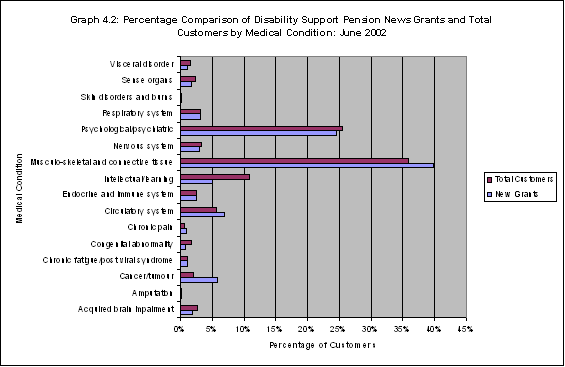
Source: Superstar Common Events Databases 14/07/01 to 16/06/2002
| MEDICAL CONDITION |
Male
|
%
|
Female
|
%
|
New Grant
|
%
|
Total Customers
|
%
|
|---|---|---|---|---|---|---|---|---|
| Acquired brain impairment | 1,250 | 2.35% | 480 | 1.37% | 1,730 | 1.96% | 16,666 | 2.72% |
| Amputation | 151 | 0.28% | 38 | 0.11% | 189 | 0.21% | 1,685 | 0.28% |
| Cancer/tumour | 3,133 | 5.88% | 2,083 | 5.96% | 5,216 | 5.92% | 12,831 | 2.09% |
| Chronic fatigue/post viral syndrome | 381 | 0.72% | 626 | 1.79% | 1,007 | 1.14% | 6,239 | 1.02% |
| Congenital abnormality | 391 | 0.73% | 313 | 0.90% | 704 | 0.80% | 10,715 | 1.75% |
| Chronic pain | 392 | 0.74% | 434 | 1.24% | 826 | 0.94% | 4,747 | 0.77% |
| Circulatory system | 4,591 | 8.62% | 1,485 | 4.25% | 6,076 | 6.89% | 35,485 | 5.79% |
| Endocrine and immune system | 1,374 | 2.58% | 970 | 2.78% | 2,344 | 2.66% | 15,043 | 2.46% |
| Intellectual/learning | 2,821 | 5.30% | 1,727 | 4.94% | 4,548 | 5.16% | 67,090 | 10.95% |
| Musculo-skeletal and connective tissue | 21,116 | 39.66% | 14,020 | 40.14% | 35,136 | 39.85% | 219,740 | 35.86% |
| Nervous system | 1,392 | 2.61% | 1,237 | 3.54% | 2,629 | 2.98% | 20,505 | 3.35% |
| Psychological/psychiatric | 12,657 | 23.77% | 9,119 | 26.11% | 21,776 | 24.70% | 155,998 | 25.46% |
| Respiratory system | 1,747 | 3.28% | 1,143 | 3.27% | 2,890 | 3.28% | 19,772 | 3.23% |
| Skin disorders and burns | 128 | 0.24% | 95 | 0.27% | 223 | 0.25% | 1,677 | 0.27% |
| Sense organs | 948 | 1.78% | 668 | 1.91% | 1,616 | 1.83% | 14,641 | 2.39% |
| Visceral disorder | 645 | 1.21% | 449 | 1.29% | 1,094 | 1.24% | 9,460 | 1.54% |
| Not coded | 127 | 0.24% | 40 | 0.11% | 167 | 0.19% | 411 | 0.07% |
| Total* | 53,244 | 100.00% | 34,927 | 100.00% | 88,171 | 100.00% | 612,705 | 100.00% |
Source: Superstar Common Events Databases 14/07/01 to 16/06/02; Superstar Pensions Database 16/06/02
* Excludes customers granted prior to 12/11/91 (46,210 customers).
4.3 New Claims Rejected by Reason and Gender
During the period 17 June 2001 to 16 June 2002, there were 42,457 claims for DSP rejected. This represents 32.5% of total claims processed. The main reasons for rejecting the claim were because the customer had less than 20 points impairment as assessed under the Impairment Tables, or had a short-term disability.
Females were more likely then males to be rejected because the disability was short‑term. Males were more likely than females to be rejected due to compensation.
| REJECTION REASON |
Male
|
%
|
Female
|
%
|
total
|
%
|
|---|---|---|---|---|---|---|
| <20 points impairment | 12,049 | 47.22% | 8,287 | 48.92% | 20,336 | 47.90% |
| Disability is short term | 3,801 | 14.90% | 2,721 | 16.06% | 6,522 | 15.36% |
| Failed to reply to correspondence | 2,719 | 10.66% | 1,753 | 10.35% | 4,472 | 10.53% |
| Other | 1,183 | 4.64% | 776 | 4.58% | 1,959 | 4.61% |
| > 20 points, can work full time | 1,171 | 4.59% | 532 | 3.14% | 1,703 | 4.01% |
| Compensation | 1,172 | 4.59% | 494 | 2.92% | 1,666 | 3.92% |
| Failed to undergo medical exam | 875 | 3.43% | 573 | 3.38% | 1,448 | 3.41% |
| Withdrawn/voluntary surrender | 597 | 2.34% | 451 | 2.66% | 1,048 | 2.47% |
| Income/Assets over limit | 859 | 3.37% | 654 | 3.86% | 1,513 | 3.56% |
| > 20 points, can be reskilled | 404 | 1.58% | 188 | 1.11% | 592 | 1.39% |
| Not residentially qualified | 230 | 0.90% | 194 | 1.15% | 424 | 1.00% |
| Not residentially qualified | 140 | 0.55% | 96 | 0.57% | 236 | 0.56% |
| Failed to attend interview | 121 | 0.47% | 67 | 0.40% | 188 | 0.44% |
| Doesn't meet age requirements | 57 | 0.22% | 67 | 0.29% | 106 | 0.25% |
| Not coded | 57 | 0.22% | 31 | 0.18% | 88 | 0.21% |
| Incapacitated/blinded overseas | 41 | 0.16% | 43 | 0.25% | 84 | 0.20% |
| Claim lodged early | 12 | 0.05% | 13 | 0.08% | 25 | 0.06% |
| Not permanently blind | 10 | 0.04% | 9 | 0.05% | 19 | 0.04% |
| Cus/ptr failed to advise TFN | 9 | 0.04% | 5 | 0.03% | 14 | 0.03% |
| Whereabouts unknown | 9 | 0.04% | 5 | 0.03% | 14 | 0.03% |
| Total | 25,516 | 100.00% | 16,941 | 100.00% | 42,457 | 100.00% |
Source: Superstar Common Events Databases 14/07/01 to 16/06/02
5:Where DSP Customers Are Coming From And Going To
5.1 Where DSP Customers Are Coming From
There were 79,450 people receiving DSP in June 2002 who were not receiving DSP in June 2001. These “new customers” represent 12.1% of the total DSP population as at June 2002.
The largest group of people entering DSP are those who were not previously receiving an income support payment. These comprise 44.1% of new customers on payment. The next largest source of DSP customers is transfers from Newstart Allowance with 35.0% of new customers, followed by Parenting Payment (both Single and Partnered) with 4.7% of new DSP customers. A large group of customers (16.2%) have their origins from a range of other payments such as Youth Allowance, Carer Payment and Special Benefit although the numbers from each payment are small. These proportions have remained fairly static for at least the last few financial years.
It should be noted that figures for customer transfers do not exactly match those for new grants due to the different business rules used in extracting these data sets, for example, some new grants can be for the same customer or a customer may be granted DSP and then leave DSP within the same year.
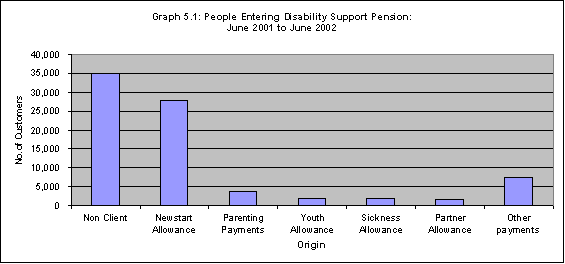
Source: FaCS Data Map, Payment to Payment Reports
| Origin | Count | % |
|---|---|---|
| Non Client | 35,070 | 44.14% |
| Newstart Allowance | 27,787 | 34.97% |
| Parenting Payments | 3,754 | 4.72% |
| Youth Allowance | 1,974 | 2.48% |
| Sickness Allowance | 1,764 | 2.22% |
| Partner Allowance | 1,621 | 2.04% |
| Other payments | 7,480 | 9.41% |
| Total | 79,450 | 100.00% |
Source: FaCS Data Map, Payment to Payment Reports
5.2 Where DSP Customers Are Going To
The majority of customers who were on DSP in June 2001 but were not on DSP in June 2002 moved on to Age Pension (52.5%). As customers reach Age Pension eligibility age the vast majority transfer across although a very small percentage of customers choose to remain on DSP. In January 2002 the qualifying age for women to claim Age Pension increased by six months to 62 years. This reduced the number of DSP customers moving onto Age Pension from 30,028 over the 2000-01 financial year to 25,315 over the 2001-02 financial year.
Of the people who left DSP, 23.2% left payments entirely. A substantial proportion (19.1%) of exits from DSP was because of the death of the customer.
Source: FaCS Data Map, Payment to Payment Reports
| Destination | Count | % |
|---|---|---|
| Age Pension | 25,315 | 52.54% |
| Non Client | 11,164 | 23.17% |
| Deceased | 9,190 | 19.07% |
| Newstart/Youth Allowance | 672 | 1.39% |
| Other payments | 1,839 | 3.82% |
| Total | 48,180 | 100.00% |
Source: FaCS Data Map, Payment to Payment Reports
Last updated:

